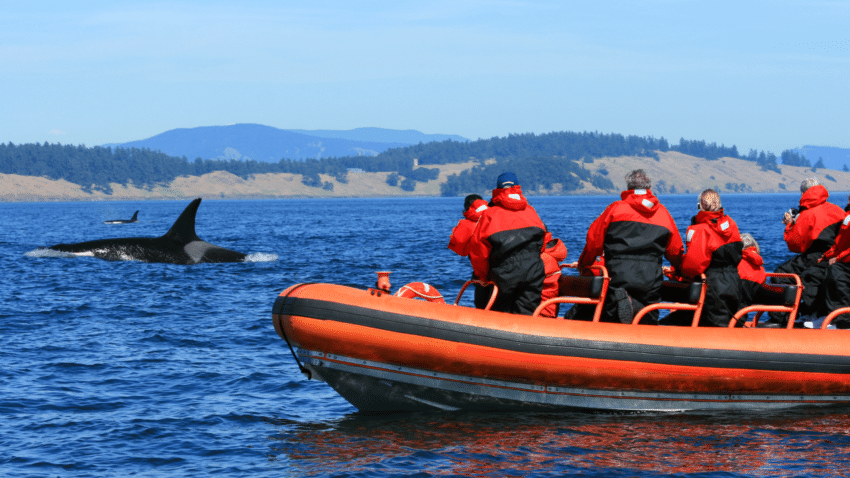Table of Contents

With the busy holiday season now behind us, the start of a new year is the perfect time to take stock to see how well, or otherwise, you are meeting your business goals. A thorough year-end tour business review and reflection is vital for your tour and activity operations. It’s an opportunity to unravel the past year, learn from it and position yourself for success. There’s no better way to maintain, or at least plan for, progressive year-on-year improvement for your business.
In this first of a two-part series of articles on the ins and outs of tour business reviews and goal-setting, we’ll dive into key questions, essential metrics (and the stories they tell) and other aspects of reflecting on the past year—so you can plan for an even better year ahead.
Four important tour business review areas to focus on
One challenge you may face when preparing to reflect on the past year is deciding what exactly to focus on, so we’ve done that part for you. Here are the four main areas to spend the most time reflecting on:
1. Reflecting on customer satisfaction and feedback

Dive into the stories your customers are telling through reviews and testimonials. While positive reviews are extremely useful for revealing what you do well, you also need to sift through customer feedback to spot any areas of improvement. These could range from quick wins, such as updating some out-of-date content on your website, to deeper issues that may have developed, or could develop if you ignore customer feedback.
2. Financial review for tour businesses

This is where you develop the economic picture of your business. Carefully review your revenue, profit margins and pricing strategy success against your current business goals. Taking a strategic approach to reviewing your finances can reveal areas you need to improve to meet your goals, or even tweaks you could make to your business goals for the upcoming year. Are your goals realistic and attainable? Or maybe they’re not ambitious enough?
3. Reviewing operational efficiency
Evaluate the inner workings of your tour business operations to spot bottlenecks or challenges and identify inefficiencies. Doing this will help you streamline processes for smoother experiences for both you and your customers—leading to financial savings and improved customer satisfaction.
4. Tour business marketing and promotion

In a competitive sector like tourism, effective marketing is key. Closely examine the success or otherwise of your marketing campaigns. How good a job have you done of reaching and engaging with your target audience(s) on the various platforms you use? Assess which channels and social media platforms work well and which ones need more attention.
Five year-end business reflection questions
Reflecting back is crucial to moving your business forward. As you work through the four areas above, ask yourself some questions to help you gather your thoughts and focus on what’s important. There are many questions you could consider, but we’ve narrowed the list down to these five key ones:
- What were your highlights and success stories of the year?
- In what specific areas did your business face challenges or setbacks?
- What feedback—good and bad—did you receive from customers, and how can you use it for improvement?
- Were your marketing efforts successful in attracting and retaining customers, and pushing your business forward?
- How well did your financial performance align with your initial goals and projections?
For more ideas of what to consider as you reflect on the past year, this article includes a handy set of 25 end-of-year reflection questions, covering everything from team dynamics to customer relationships.
Five key tour business metrics to consider
Metrics are numerical storytellers. The numbers behind your business performance play a pivotal role in your year-end review. By identifying benchmarks, they enable you to gauge the success of your strategic initiatives, identify areas of improvement and make informed decisions based on objective data rather than subjective assessments or “gut feelings.”
Metrics are also crucial to planning for the year ahead. By analyzing your business’s historical performance, you can set realistic and achievable goals for the upcoming year. Here are five metrics to focus on:
1. Customer Retention Rate

Your customer retention rate measures how many customers stick with your business over time. Imagine you have 100 customers, and by the end of the year you still have 80 of them. That means you have a customer retention rate of 80%. That represents the percentage of customers who keep buying from you instead of a competitor. A high retention rate means your customers are happy and keep coming back. Forming these lasting relationships should be a priority for any tour business.
2. Net Promoter Score (NPS)
NPS measures how likely your customers are to recommend your business to others. It’s another way to assess overall customer satisfaction and loyalty. NPS simply involves asking your customers one question through a follow-up survey: “On a scale of 0 to 10, how likely are you to recommend our product/service to a friend or co-worker?”
3. Revenue Growth

Your revenue growth is represented by the percentage increase in the total money your business made over the last year. If last year you earned $2m and this year it’s $3m, your revenues grew by 50%.
4. Conversion Rates
Your conversion rate measures how well you turn website visitors and prospects into paying customers. It’s represented by the percentage of people who visit your website or call you and actually book a tour or activity. For example, if 1,000 people visit your website in response to a marketing campaign, and 100 make a booking, your conversion rate for that campaign is 10%.
5. Operational Costs and Efficiency Metrics

These metrics provide a window into the internal workings of your business. Operational costs are the everyday expenses of running your business, such as wages, rent and utilities. Efficiency metrics can tell you how well you’re using resources to run your business smoothly. They measure things like how quickly you can respond to customer queries.
How to handle the emotional elements of a year-end review
Of course, reflection isn’t just about numbers; it can involve a rollercoaster of emotions as you celebrate successes and front up to challenges and missteps. Above all, approach this time of reflection as the best way to learn from your good and bad experiences during the past year. Take a positive and growth-oriented mindset, and seek diverse perspectives from customers and staff alike. Within your business, aim to foster a culture of continuous improvement that focuses on lessons learned.

Turning year-end business reflection into action
Use the insights, stories and data you uncover to inform your planning and develop a roadmap for the next year. We’ll get into that more in our next article, but for now, here are your next steps:
Set goals:

Use reflections to set specific goals that provide a clear direction.
Create actionable steps:
Break your goals down into actionable steps to ensure they’re not just flights of fancy or unformed ideas but practical pathways toward improvement.
Make a roadmap:
Assign responsibilities and establish timelines to add accountability. This transforms your plan from a wish list into a strategic agenda that builds on your reflection and drives your business forward.

Set yourself up for a year of success
A thorough end-of-year tour business review and reflection should become an annual activity built into your calendar. Done well, it can be one of the main drivers for the continuing success of your tour business. Remember to involve your staff. You could even build in team-building elements and activities, such as hosting an annual retreat somewhere off-site to bring everyone together in a more convivial atmosphere than the office.
The next crucial step is to take what you learn and look forward to the next 12 months and how you can grow your business. In the next article, we’ll explore how strategic and informed goal-setting and decision-making can shape the direction and trajectory of your tour and activity business.





